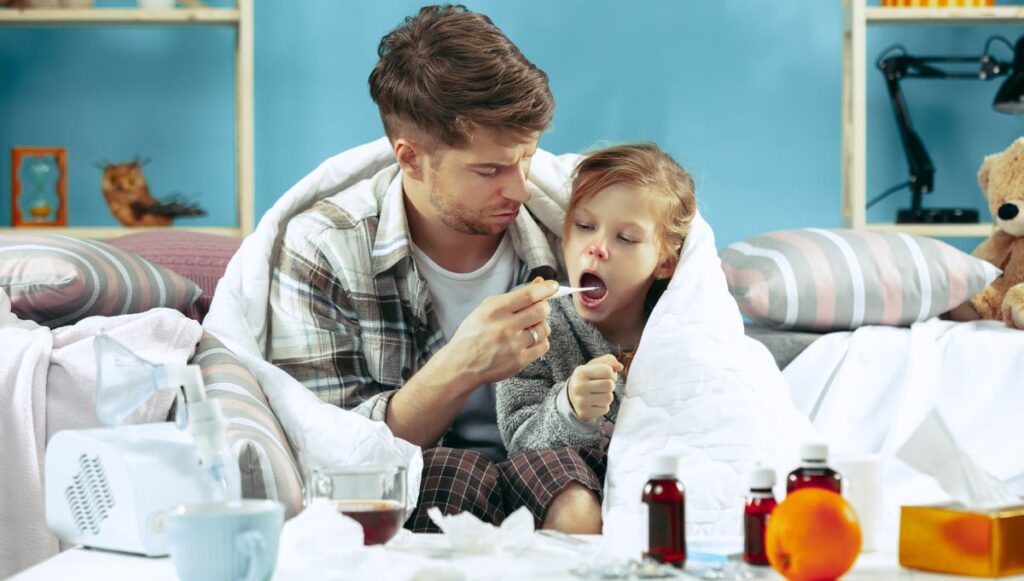Children’s Health in Focus: Child Care Best Practices for Cough, Cold, and Fever : As a child care provider, you play a vital role in promoting the well-being of the children you serve. In the ever-changing landscape of children’s health, managing and preventing common ailments like coughs, colds, and fevers is a top priority. Understanding best practices for their management is crucial to creating a safe and nurturing child care environment.
Table of Contents
Exploring the Usual Suspects: Coughs, Colds, and Fevers
Before delving into best practices, it’s essential to understand the common health issues that children often encounter.
Causes:
Coughs:
Children frequently get coughs, which can be caused by a number of things such as respiratory infections, allergies, asthma, or irritants like smoke and dust. In order to provide the right care, it is essential to comprehend the underlying causes. While the occasional cough is usually harmless and a natural defensive mechanism of the body, chronic or severe coughs may need medical care. It’s critical to keep an eye on symptoms like fever, dyspnea, or chest pain. To ensure the child’s wellbeing, utilize over-the-counter cough drugs with caution and see a pediatrician for a precise diagnosis and customized treatment plan.
Colds:
Colds are a common childhood ailment that can make little ones feel under the weather. These viral infections typically cause symptoms like a runny or stuffy nose, sneezing, coughing, and sometimes a mild fever. While colds are usually not serious, they can be uncomfortable for children. Good hygiene practices, such as frequent handwashing and covering sneezes, can help prevent the spread of cold viruses. Rest, plenty of fluids, and gentle care from parents or caregivers are essential for a child’s recovery. It’s important to consult a pediatrician if symptoms worsen or persist, as sometimes a cold can lead to complications like ear infections. With a little extra care and comfort, kids can bounce back to their energetic selves in no time.
Fevers:
Children’s fevers are frequently caused by infections and other ailments. They happen when the body temperature goes above the typical level. Numerous things, including as bacterial or viral illnesses, teething, or vaccinations, can result in fevers. Although a fever is typically the body’s response to an infection, it can cause anxiety in parents and children alike. It’s critical to keep an eye on a child’s fever and search for any concomitant symptoms such as fatigue, thirst, or dyspnea. Use of over-the-counter fever-reducing drugs is permitted with a pediatrician’s supervision. The key to the child’s rehabilitation is making sure they receive enough sleep and stay hydrated. It’s imperative to consult a doctor if a fever continues, gets worse, or is accompanied by worrisome symptoms in order to rule out any

Symptoms:
Coughs:
Coughing is a common symptom of various underlying conditions, and the specific symptoms may vary depending on the cause of the cough. Here are some general symptoms often associated with a cough
1. Coughing:
Coughing in children is a natural reflex action by the body to clear the airways of irritants, mucus, or foreign substances. It involves a forceful expulsion of air from the lungs through the mouth, often accompanied by distinctive sounds. Coughs in children can be triggered by various factors, including respiratory infections, allergies, or underlying medical conditions. They come in different types, such as dry or productive coughs, with management and care tailored to a child’s specific needs to ensure their well-being and comfort.
2. Throat Irritation:
Throat irritation refers to a scratchy, uncomfortable sensation in the throat, often accompanied by a desire to clear the throat or cough. It can result from various factors, including viral or bacterial infections, allergies, environmental irritants like smoke or pollution, and excessive throat dryness. The discomfort may be temporary, but persistent or severe throat irritation may indicate an underlying condition that requires medical attention and appropriate treatment.
3. Chest Discomfort:
Chest discomfort is a common complaint in children, and it can be caused by a variety of factors, including respiratory infections, acid reflux, costochondritis, muscle strains, and anxiety. The pain may be sharp, dull, or tight, and it may be located in the center of the chest, on the left or right side, or near the back.
If your child complains of chest discomfort, it is important to take them to see a doctor to rule out any serious underlying medical conditions. In the meantime, you can help to relieve your child’s discomfort by encouraging them to rest, giving them plenty of fluids to drink, using a humidifier or taking a steamy shower, elevating their head at night, and giving them over-the-counter pain relievers, such as ibuprofen or acetaminophen, as directed by your doctor.
4. Phlegm or Mucus:
Phlegm, also known as mucus, is a normal substance produced by the body to protect the airways and trap dust and other irritants. However, too much phlegm can make it difficult for children to breathe and can also lead to coughing.
There are a number of things that can cause children to produce too much phlegm, including colds and other respiratory infections, allergies, asthma, cystic fibrosis, bronchiectasis, and pneumonia. If your child is producing a lot of phlegm, it is important to see a doctor to rule out any serious underlying medical conditions.
5. Shortness of Breath:
Shortness of breath, also known as dyspnea, is a common complaint in children. It can be caused by a variety of factors, including respiratory infections, congenital heart defects, allergies, cystic fibrosis, anemia, obesity, and anxiety.
If your child is experiencing shortness of breath, it is important to take them to see a doctor to rule out any serious underlying medical conditions. In the meantime, you can help to relieve your child’s discomfort by encouraging them to rest, sitting them upright, using a humidifier or taking a steamy shower, and giving them over-the-counter pain relievers, such as ibuprofen or acetaminophen, as directed by your doctor.
If your child’s shortness of breath is severe, or if it is accompanied by other symptoms such as difficulty breathing at rest, wheezing, chest pain, blue lips or fingernails, or lethargy or confusion, seek medical attention immediately.
6. Wheezing:
Wheezing in children is a common respiratory symptom characterized by a high-pitched, whistling sound during exhalation, often indicative of underlying conditions such as asthma, viral infections, allergies, bronchiolitis, or environmental factors like secondhand smoke exposure. Prompt medical evaluation is crucial when children wheeze, as it aids in identifying the root cause and determining appropriate treatment, which may include medications or environmental interventions to ensure their respiratory health.
Colds:
The common cold is a viral infection of the upper respiratory tract that is most common in children. It is usually mild and goes away on its own within seven to 10 days. Symptoms include a runny or stuffy nose, sneezing, a sore throat, coughing, and a low-grade fever. There is no cure for the cold, but treatment focuses on relieving symptoms and making the child feel more comfortable. Tips for relieving symptoms include giving the child plenty of fluids to drink, using a humidifier or taking a steamy shower, elevating the child’s head at night, and giving them over-the-counter pain relievers, such as ibuprofen or acetaminophen, as directed by a doctor.
Fevers:
A fever is a temporary increase in your body’s temperature. It’s a normal response to an infection or illness.
The average body temperature is 98.6 F (37 C). A fever is generally considered to be 100.4 F (38 C) or higher in children.
The most common cause of fever in children is a viral infection, such as the common cold, the flu, or a stomach flu. Other causes of fever in children include:
- Bacterial infections, such as pneumonia, ear infections, and strep throat
- Teething
- Immunizations
- Heatstroke
- Certain medications
Symptoms of fever in children
Symptoms of fever in children can include:
- A high temperature
- Chills
- Sweating
- Headache
- Muscle aches
- Fatigue
- Loss of appetite
- Irritability
Preventative Measures: Building a Healthy Environment
Prevention is the first line of defense against coughs, colds, and fevers in a child care setting. Here are some preventative measures you can implement:
1. Hand Hygiene:
Encourage frequent handwashing for both children and staff. Proper handwashing with soap and water for at least 20 seconds can significantly reduce the spread of germs.
2. Respiratory Hygiene:
each children to cover their mouths and noses with tissues or their elbows when they cough or sneeze. Make it a fun and interactive learning experience.
3. Cleaning and Disinfecting:
Regularly clean and disinfect commonly touched surfaces and toys to reduce the risk of illness transmission.
4. Ventilation:
Ensure good indoor air quality by proper ventilation. Consider the use of air purifiers with HEPA filters to improve air quality.
Nutrition and Hydration
Nutrition and hydration are essential for children’s growth and development. A healthy diet and drinking plenty of fluids helps children maintain a healthy weight, build strong muscles and bones, and have the energy they need to learn and play.
A healthy diet for children should include a variety of foods from all food groups, including fruits and vegetables, whole grains, lean protein, low-fat dairy, and healthy fats. Water is the best choice for hydration, but children can also drink milk, 100% fruit juice, and unsweetened beverages such as tea and herbal water.
Here are some tips for encouraging healthy eating and drinking habits in children:
- Make mealtimes family time.
- Offer a variety of healthy foods and drinks at each meal and snack.
- Be a good role model.
- Avoid using food as a reward or punishment.
- Make healthy eating and drinking fun.
Treatment and Care Tips
In the event that a child in your care develops a cough, cold, or fever, here are some tips for care and treatment:
Coughs and Colds:
- Encourage rest and hydration.
- Use a humidifier to ease congestion.
- Over-the-counter cough and cold medicines are not recommended for young children. Always consult with a healthcare provider before giving any medication.
Fevers:
- Encourage the child to rest.
- Keep the child well-hydrated.
- Monitor the fever and consult a healthcare provider if it becomes high or persists.

Conclusion
Child care providers hold a vital responsibility in safeguarding children’s health, especially when it comes to managing common ailments like coughs, colds, and fevers. By implementing preventative measures, promoting good hygiene practices, providing nutritious meals, and maintaining clear communication with parents, you can create a safe and nurturing child care environment where children can thrive. Always stay informed about the latest health guidelines and be prepared to adapt to changing circumstances to ensure the well-being of the little ones in your care. Remember, a focus on prevention and appropriate care and treatment is the cornerstone of effective child care management.

